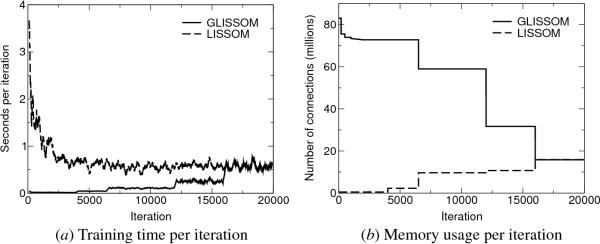
Click on the image to see a PDF version (for zooming in)
Fig. 15.4. Training time and memory usage in LISSOM vs.
GLISSOM. Data are shown for a LISSOM network of 144 × 144 units and a
GLISSOM network grown from 36 × 36 to 144 × 144 units as described in
Section 15.4.2. (a) Each line shows a 20-point running average of the
time spent in training for one iteration, with a data point measured
every 10 iterations. Only training time is shown; times for
initialization, plotting images, pruning, and scaling networks are not
included. Computational requirements of LISSOM peak at the early
iterations, falling as the excitatory radius (and thus the number of
neurons activated by a given pattern) shrinks and as the neurons
become more selective. In contrast, GLISSOM requires little
computation time until the final iterations. Because the total
training time is determined by the area under each curve, GLISSOM is
much more efficient to train overall. (b) Each line shows the number
of connections simulated at a given iteration. LISSOM's memory usage
peaks at early iterations, decreasing at first in a series of small
drops as the lateral excitatory radius shrinks, and then later in a
few large drops as long-range inhibitory weights are pruned at
iterations 6500, 12,000, and 16,000. Similar shrinking and pruning
takes place in GLISSOM, while the network size is scaled up at
iterations 4000, 6500, 12,000, and 16,000. Because the GLISSOM map
starts out small, memory usage peaks much later, and remains bounded
because connections are pruned as the network is grown. As a result,
the peak number of connections (which determines the memory usage) in
GLISSOM is as low as the smallest number of connections in LISSOM.
|